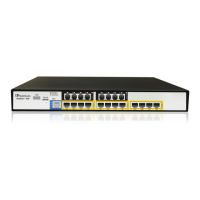The figure below provides a simplified illustration of the device's handling of IP-to-IP call
routing:
Figure 22-1: Basic Schema of the Device's IP-to-IP Call Handling
The basic IP-to-IP call handling process can be summarized as follows:
1. Incoming IP calls are identified as belonging to a specific logical entity in the network
referred to as a Source IP Group, according to Inbound IP Routing rules.
2. The Source IP Group is sent to a specific IP Group referred to as a Destination IP
Group; the IP destination address being as configured by the Proxy Set associated
with the Destination IP Group.
3. Number manipulation can be done on inbound and outbound legs.
The following subsections discuss the main terms associated with the IP-to-IP call routing
application.
22.1.1 Proxy Sets
A Proxy Set is a group of Proxy servers (for Proxy load balancing and redundancy) defined
by IP address or fully qualified domain name (FQDN). The Proxy Set is assigned to Server-
type IP Groups only, representing the address of the IP Group to where the device sends
the INVITE message (i.e., the destination of the call). Typically, for IP-to-IP call routing,
two Proxy Sets are defined for call destination – one for each leg (i.e., one for each IP
Group) of the call (i.e., both directions).
22.1.2 IP Groups
An IP Group represents a logical SIP entity in the device's network environment such as an
ITSP SIP trunk, Proxy/Registrar server, IP-PBX, or remote IP-PBX users. The address of
the IP Group is typically defined by its associated Proxy Set.
The opposite legs of the call are each presented by an IP Group; one being a Serving IP
Group the other a Served IP Group. The Serving IP Group denotes the IP Group that
provides service (e.g., ITSP) to the Served IP Group (e.g., IP-PBX). This is the IP Group to
where the device sends INVITE messages received from the Served IP Group as well as
REGISTER messages for registering on behalf of the Served IP Group.
IP Group can be a Server or User type. For Server-type IP Groups (e.g., ITSP or IP-PBX),
the destination address (defined by the Proxy Set) is known. In contrast, User-type IP
Groups represents groups of users whose location is dynamically obtained by the device
when REGISTER requests and responses traverse (or are terminated) by the device.
Generally, these are remote IP-PBX users (e.g., IP phones and soft phones).
For registrations of User-type IP Groups, the device updates its internal database with the
AOR and Contacts of the users (see the figure below) Digest authentication using SIP

